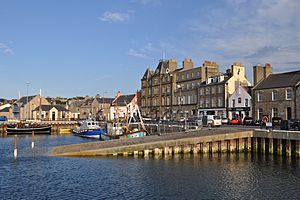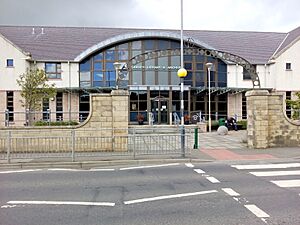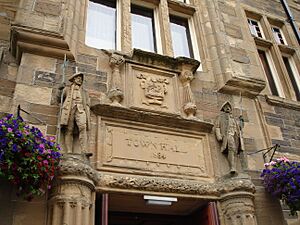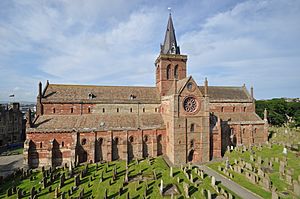Kirkwall facts for kids
Quick facts for kids Kirkwall
|
|
|---|---|
 Kirkwall Harbour in August 2014 |
|
| Area | 4.00 km2 (1.54 sq mi) |
| Population | 10,020 (2020) |
| • Density | 2,505/km2 (6,490/sq mi) |
| Demonym | Kirkwallian |
| OS grid reference | HY449109 |
| • Edinburgh | 210 mi (340 km) |
| • London | 528 mi (850 km) |
| Council area | |
| Lieutenancy area | |
| Country | Scotland |
| Sovereign state | United Kingdom |
| Post town | KIRKWALL |
| Postcode district | KW15 |
| Dialling code | 01856 |
| Police | Northern |
| Fire | Highlands and Islands |
| Ambulance | Scottish |
| EU Parliament | Scotland |
| UK Parliament |
|
| Scottish Parliament |
|
Kirkwall (also called Scots: Kirkwa, Kirkwaa, or Kirkwal) is the biggest town in Orkney. Orkney is a group of islands (an archipelago) north of mainland Scotland. Kirkwall is a very old town, first mentioned in a Viking story called the Orkneyinga saga.
Today, Kirkwall is the main hub for the Orkney Islands. It's where the local government is based, and it's a busy port. Ferries leave from here to many places. Kirkwall is also home to the St Magnus Festival, a big arts event. Many cruise ships stop here too. The famous St Magnus Cathedral stands right in the middle of the town.
Contents
- What's in a Name? Kirkwall's Meaning
- A Look Back: Kirkwall's History
- Running the Show: Kirkwall's Government
- Where is Kirkwall? Geography and Climate
- People of Kirkwall: Demographics
- Making a Living: Kirkwall's Economy
- Fun and Learning: Culture and Community
- Cool Places to See: Landmarks
- Getting Around: Transport
- Learning in Kirkwall: Education
- Places of Worship: Religious Sites
- Staying Active: Sport
- Friends Around the World: Twin Town
- Famous Faces: Notable People
- See also
What's in a Name? Kirkwall's Meaning
The name Kirkwall comes from an old Norse word, Kirkjuvágr. This means "church bay". The town was started by the Norsemen (Vikings) around the 11th century.
Even in 1525, the town's name was written as Kirkevaag. Over time, this changed to "Kirkwaa" and then to Kirkwall. How the "vágr" part became "wall" isn't fully clear.
A Look Back: Kirkwall's History
Kirkwall was first written about in the Orkneyinga saga in the year 1046. At that time, it was where Rögnvald Brusason, the Earl of Orkney, lived. He was later killed by his uncle, Thorfinn the Mighty.
In 1486, King James III of Scotland made Kirkwall a royal burgh. This meant it was a special town with certain rights. It even sent a representative to the Parliament of Scotland.
After Scotland joined with England in 1707, Kirkwall teamed up with other towns. Together, they sent one Member of Parliament (MP) to the British House of Commons. In 1918, Kirkwall's own parliamentary area joined the larger Orkney and Shetland area.
Ancient Homes: Earth Houses
On the western edge of Kirkwall, you can find a very old monument called the "Grain Earth House". It's a short, low passage made of stone, deep underground. This passage leads to a small room with pillars.
These types of underground structures are called "souterrains". They are common in the Northern Isles. The Grain Earth House is unusually deep. It was once connected to a home on the surface, but that home is now gone. We still don't know the exact purpose of these Iron Age buildings. Another similar structure, the Rennibister Earth House, is found further west.
Running the Show: Kirkwall's Government
Kirkwall is the main administrative center for Orkney. It's where the Orkney Islands Council (the local government) and NHS Orkney (the health service) have their main offices.
Sometimes people call Kirkwall "The City and Royal Burgh of Kirkwall". However, it's not officially a city.
Where is Kirkwall? Geography and Climate
Kirkwall is about 210 miles (338 km) north of Edinburgh. It sits on the northern coast of Mainland, Orkney, which is the largest island in Orkney. Its harbors are in the bay of Kirkwall. Scapa Flow, a famous body of water, is about 1.4 miles (2.3 km) to the south.
Kirkwall has a cool, wet oceanic climate. This means the ocean strongly affects its temperatures. Summers are generally cooler than in other parts of the UK. However, Kirkwall tends to be warmer than Shetland because it's closer to mainland Scotland.
| Climate data for Kirkwall, 26m asl, 1991–2020 normals, Extremes 1951– | |||||||||||||
|---|---|---|---|---|---|---|---|---|---|---|---|---|---|
| Month | Jan | Feb | Mar | Apr | May | Jun | Jul | Aug | Sep | Oct | Nov | Dec | Year |
| Record high °C (°F) | 12.2 (54.0) |
12.8 (55.0) |
18.9 (66.0) |
21.0 (69.8) |
22.0 (71.6) |
22.8 (73.0) |
25.6 (78.1) |
24.8 (76.6) |
22.8 (73.0) |
19.4 (66.9) |
14.5 (58.1) |
12.9 (55.2) |
25.6 (78.1) |
| Mean maximum °C (°F) | 9.9 (49.8) |
10.4 (50.7) |
12.3 (54.1) |
14.5 (58.1) |
17.4 (63.3) |
19.1 (66.4) |
20.6 (69.1) |
20.1 (68.2) |
18.7 (65.7) |
15.1 (59.2) |
12.4 (54.3) |
11.0 (51.8) |
21.5 (70.7) |
| Mean daily maximum °C (°F) | 6.6 (43.9) |
6.8 (44.2) |
8.0 (46.4) |
9.9 (49.8) |
12.2 (54.0) |
14.2 (57.6) |
16.1 (61.0) |
16.2 (61.2) |
14.4 (57.9) |
11.6 (52.9) |
8.9 (48.0) |
7.0 (44.6) |
11.0 (51.8) |
| Daily mean °C (°F) | 4.5 (40.1) |
4.5 (40.1) |
5.4 (41.7) |
7.0 (44.6) |
8.5 (47.3) |
11.3 (52.3) |
13.2 (55.8) |
13.4 (56.1) |
11.8 (53.2) |
9.3 (48.7) |
6.7 (44.1) |
4.8 (40.6) |
8.4 (47.1) |
| Mean daily minimum °C (°F) | 2.3 (36.1) |
2.1 (35.8) |
2.7 (36.9) |
4.1 (39.4) |
5.8 (42.4) |
8.4 (47.1) |
10.3 (50.5) |
10.5 (50.9) |
9.2 (48.6) |
7.0 (44.6) |
4.5 (40.1) |
2.6 (36.7) |
5.8 (42.4) |
| Mean minimum °C (°F) | −1.6 (29.1) |
−1.9 (28.6) |
−1.7 (28.9) |
−0.3 (31.5) |
1.1 (34.0) |
4.3 (39.7) |
6.3 (43.3) |
6.3 (43.3) |
4.4 (39.9) |
2.2 (36.0) |
0.3 (32.5) |
−1.7 (28.9) |
−3.2 (26.2) |
| Record low °C (°F) | −7.8 (18.0) |
−7 (19) |
−6.8 (19.8) |
−4.9 (23.2) |
−2.1 (28.2) |
1.0 (33.8) |
0.0 (32.0) |
3.7 (38.7) |
0.5 (32.9) |
−1.6 (29.1) |
−5.5 (22.1) |
−7.6 (18.3) |
−7.8 (18.0) |
| Average precipitation mm (inches) | 114.7 (4.52) |
96.2 (3.79) |
86.7 (3.41) |
59.2 (2.33) |
53.8 (2.12) |
55.9 (2.20) |
58.2 (2.29) |
73.0 (2.87) |
90.7 (3.57) |
119.8 (4.72) |
126.1 (4.96) |
114.3 (4.50) |
1,048.6 (41.28) |
| Average precipitation days (≥ 1.0 mm) | 20.4 | 17.6 | 16.9 | 14.1 | 11.9 | 10.8 | 12.1 | 12.6 | 15.2 | 19.1 | 20.5 | 19.9 | 191.1 |
| Mean monthly sunshine hours | 34.1 | 64.0 | 102.0 | 144.3 | 193.5 | 145.0 | 138.8 | 134.6 | 107.8 | 76.3 | 44.0 | 26.1 | 1,210.4 |
| Source 1: Met Office | |||||||||||||
| Source 2: Royal Dutch Meteorological Institute/KMNI Infoclimat | |||||||||||||
People of Kirkwall: Demographics
The number of people living in Kirkwall has been growing steadily. In 2001, the population was 6,205. By 2011, it had grown to 9,293. In 2020, it was estimated to be 10,020.
Making a Living: Kirkwall's Economy
Kirkwall harbor is a very important business center for Orkney. It has almost 1 mile (1.6 km) of quay edge for ships to dock. There's a marina for smaller boats, and it supports fishing and diving vessels.
After a lot of work on the harbor, Kirkwall has become a popular stop for cruise ships. Many ships visit each week during the season. This has helped the town's economy and allowed many unique, independently owned shops to thrive. Each year, about 140 cruise ships visit Kirkwall and Stromness.
Weaving has been done in Orkney since Viking times. In the 1970s, a company called John Sclater & Co made Tweed fabric in Kirkwall. They used brand names like Norsaga and Jarltex.
Fun and Learning: Culture and Community
The Orkney Library and Archive is located in Kirkwall. Kirkwall is also home to one of the world's most northerly Carnegie libraries. This library was opened by Andrew Carnegie and his wife in 1909. The original building is still there, but the library moved to a bigger building in 2003.
The town has two museums. The larger one is The Orkney Museum in Tankerness House. This museum has many local historical items. It's located in one of Scotland's best-preserved 16th-century town-houses. The museum's collections from prehistoric times, the Picts, and the Viking age are very important worldwide.
The other museum is the Orkney Wireless Museum. This museum focuses on the history of radio and recorded sound. It's in an old building that might have been the harbour master's office.
The Orkney Tourist Board is in an 18th-century building on Broad Street. Kirkwall also has a Royal National Lifeboat Institution lifeboat station, which helps rescue people at sea.
One of the biggest yearly events in Kirkwall is the Ba Game. This traditional street football game is played on Christmas Day and New Year's Day. Two teams, the Uppies and the Doonies, play against each other. Each team represents a different part of the town.
Music and Movies: Media and the Arts
The famous composer Peter Maxwell Davies helped start the yearly St Magnus Festival. This festival is held in Kirkwall every midsummer and celebrates music and arts. Local music groups like the Wrigley Sisters and Bryttania also started in Kirkwall.
The Orkney Theatre, which has 384 seats, opened in 2014. It's next to Kirkwall Grammar School. It has a special pit for an orchestra, which can be used by removing some seats.
Kirkwall Harbour can be seen in a 1973 documentary called The Highlands and Islands – A Royal Tour. This film is about Prince Charles' visit to the Highlands and Islands. Scottish filmmaker Margaret Tait was born in Kirkwall. Many of her films, especially the Aspects of Kirkwall series, are set there.
Did you know that The Simpsons character Groundskeeper Willie was born in Kirkwall?
Cool Places to See: Landmarks
Kirkwall has many houses and other buildings from the 17th and 18th centuries. They are built in the local style. The Kirkwall Town Hall was finished in 1884.
Getting Around: Transport
Kirkwall is a port with ferry services to Aberdeen and Lerwick. It also has ferries to the main northern islands in the Orkney group. Hatston pier, the main ferry terminal, is about 2 miles (3.2 km) outside the town center.
Ferry services to Kirkwall have been running since 1836. Different companies have operated these services over the years, until 2002.
Kirkwall Airport, the main airport for Orkney, is about 2.5 miles (4.0 km) southeast of the town. There are no passenger train services in Kirkwall. Any nearby railways were used for industrial or military purposes.
Learning in Kirkwall: Education
Kirkwall has several schools for different age groups.
Nursery Schools
- Glaitness Nursery
- Papdale Nursery
- Strynd Nursery
- Willow Tree Nursery
Primary Schools
- Glaitness Primary School
- Papdale Primary School
Secondary Schools
- Kirkwall Grammar School
Colleges and Universities
- Orkney College UHI
- Institute of Northern Studies
The oldest school in Kirkwall, Kirkwall Grammar School, has been around since about 1200! The current school building opened in 2014.
The main campus of Orkney College is in Kirkwall. It's in a special building that opened in 2000.
Places of Worship: Religious Sites
The original "Kirk" (church) of Kirkwall was not the cathedral. It was an 11th-century church dedicated to Saint Olaf of Norway. Part of a doorway from this old church still exists. An old cupboard (called an aumbry) from the original church is inside the current Saint Olaf's Church (an Episcopal church) in Dundas Crescent.
At the very heart of the town stands St Magnus Cathedral. This cathedral was built to remember Saint Magnus Erlendsson, Earl of Orkney, who lived from 1108 to 1117. It was founded by Earl (later Saint) Rögnvald Kali. Next to the cathedral, you can see the ruins of the old Bishop's Palace and Earl's Palace.
Staying Active: Sport
The Pickaquoy Centre, Orkney's largest leisure center, is in Kirkwall. It opened in 1999 and offers many sports and activities.
Kirkwall Grammar School Sports Centre also has indoor sports facilities. It has grass and artificial sports fields that the public can use.
Friends Around the World: Twin Town
Kirkwall is twinned with:
- Moena, Trentino-Alto Adige/Südtirol (since 1996)
Famous Faces: Notable People
Many interesting people have connections to Kirkwall:
- Conran of Orkney: A bishop from the 7th century.
- Stanley Cursiter: A painter who was born in Kirkwall.
- Ola Gorie: A well-known jewelry designer.
- Peter Marshall: A historian who went to school in Kirkwall.
- Clara Anne Williams (born Rendall): A missionary and teacher born in Kirkwall in 1887. She was recognized for her Red Cross work during WWII in India.
- Ann Scott-Moncrieff: An author and writer.
See also
 In Spanish: Kirkwall para niños
In Spanish: Kirkwall para niños






